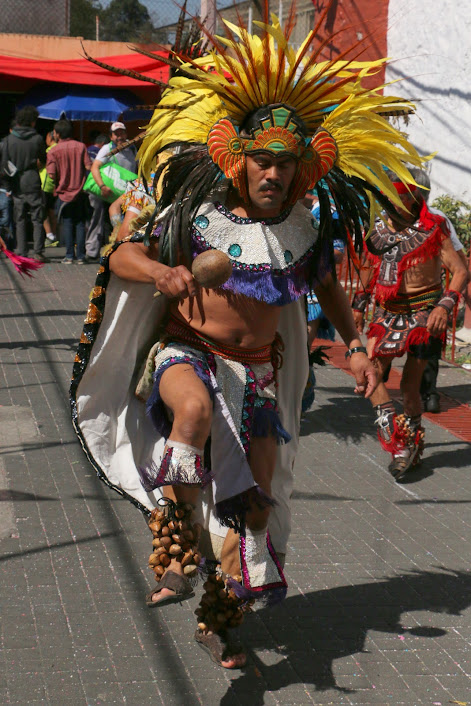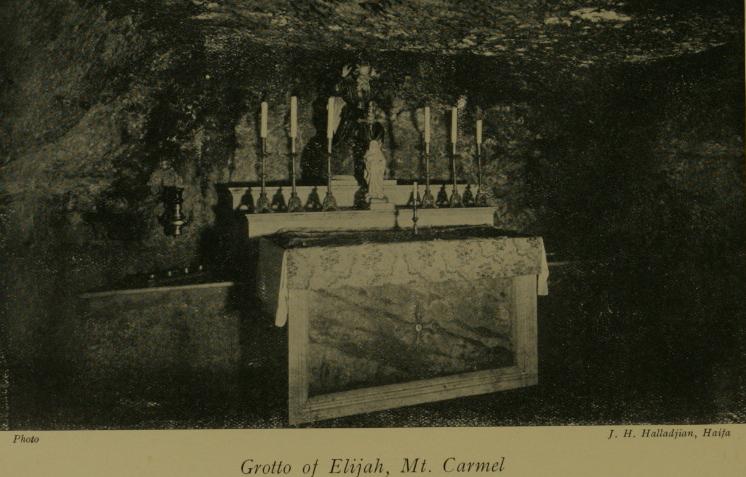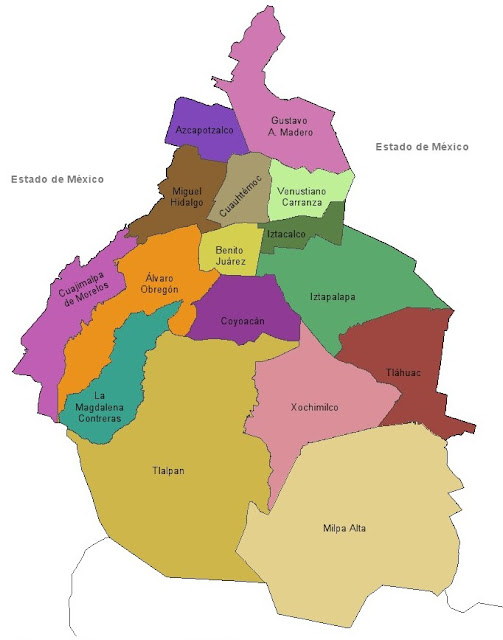River Towns
In some of our more recent ambles through the original indigenous villages of Mexico City, we have explored a group of villages in the southwestern part of the City linked by a network of small rivers that once flowed from the mountains, to the west and south, eastward into Lake Texcoco.We followed the former course of Río Churubusco from the village of San Diego Churubusco, on what was once the lakeshore, west to Xoco (HO-ko). It initially sat at the junction of two of that river's tributaries, Río Mixcoac, coming from the west, and the Río Magdalena, coming from the south. A mile farther west, we visited the village of Mixcoac (MISH-quack), alongside the river bearing its name. Traveling south, along the Río Magdalena, we visited the villages of San Ángel and Chimalistac.
The rivers are now mostly covered by highways and streets which, not coincidentally, serve as boundaries between present-day delegaciones or boroughs. The Río Churubuso-Río Mixcoac highway runs east to west, between Delegación Benito Juárez to its north and Delegación Coyoacán to its south. South of this highway, Avenida Universidad runs south, separating Coyoacán from Delegación Álvaro Obregón to the west. Universidad and some parallel streets cover Río Magdalena.
However, a small piece of riverine history has been protected from urban obliteration. Along the east side of Universidad, some blocks south of its intersection with Churubusco, there is a narrow sliver of park. It harbors a part of the Río Magdalena which remains open to the sky and to the view of passersby if they bother to venture a few yards in from the busy street.
 |
| Río Magdalena |
North of this small sliver of park, the river enters Los Viveros de Coyoacán, the Coyoacán Nurseries, actually a large arboretum used to grow trees for urban reforestation. North of the Viveros, the river is again hidden underground.
Pueblo Axotla
Across Universidad from Los Viveros, is another virtually hidden piece of history, el Pueblo Axotla. Like Xoco, its neighbor, which lies kiddy-corner across Ave. Universidad and Churubusco, Axotla (Ah-SHOW-tla) sits behind a wall of modern commercial buildings. But when we turn off the avenue onto Calle Hidalgo, we see at once that we have entered a traditional barrio. On the day of our visit, we also see colorfull announcements that today, January 20, is the day for celebrating la fiesta patronal—the day of the pueblo's patron saint, San Sebastián Mártir.
| "Long live San Sebastián Axotla" Papel picada, cut paper (actually plastic) announces the celebration of the pueblo's patron saint, and of the pueblo, itself. |
| Gateway to the atrio, atrium, a plaza-like space, in front of the church |
| Church of San Sebastián Mártir of the Pueblo of Axotla, Built by the Franciscans in the 16th century. |
We have run into San Sebastián, St. Sebastian the Martyr, before. He is the saint of San Sebastián Atzacoalco, one of the four original indigenous quarters of San Juan Tenochtitlan, the "Indian" sector the Spanish established around their central core when they turned the Mexica capital into Mexico City. He is also the patron saint of nearby Xoco and Chimalistac. Our hunch is that St. Sebastian was popular with the Franciscans who founded these churches because he was an early (third century) Christian martyr who died in defense of his new faith, thus serving as an example to the newly converted "indios".
| 16th century stone cross from the Franciscans |
Parade of the Axolotes
A few people are hanging out in the atrio. An empty stage sits to one side. Nothing is happening. So we ask those waiting, "¿Qué pasa con la fiesta?" "Is anything happening with the fiesta?"
They point to the church and say there is an anuncio on the wall listing the events of the fiesta.
They point to the church and say there is an anuncio on the wall listing the events of the fiesta.
| Anuncio, typical listing of fiesta events, from Thursday (jueves), through Monday (lunes) |
As we are reading the announcement, we suddenly hear the sound of drums coming from the street behind the church. As it is about noon, the sign tells us they are announcing el Desfile de los Axolotes, the parade of the Axolotes. We have no idea what an axolote is, but we hurry alongside the church to catch up with the parade.
| Drummers lead the parade |
Half a dozen jovenes, youths, including a señorita, set the rhythm with various size drums. This is in place of the usual brass banda.
Behind the drummers walk groups of elementary school children, each identified by a sign, 3rd, 4th, 6th...
There are also adults, mostly young, walking or riding bicycles and supporting large papier mache sculptures of strange, lizard-like creatures with feathers where their ears should be. They remind us of the alebrijes, fantastic, often dragon-like creatures, made of papier mache or other materials that are a form of popular folk art in Mexico, actually invented by a Mexico City artist, Pedro Linares, in the 1930s. We love them and have a small collection at home.
We find out, later (from Wikipedia), that these creatures are axolotls (ah-show-LOW-tls) (Ambystoma mexicanum), a kind of amphibian similar to salamanders, also known as the Mexican walking fish. Axolotls (a Nahuatl name) are unusual among amphibians in that they reach adulthood without undergoing metamorphosis. Instead of developing lungs and taking to land, the adults remain aquatic and gilled. The "feathers" are their external gills.
 |
| Axolotl Photo: Wikipedia |
Axolotls were common in the canals of Lake Xochimilco until the late 1990s, but by 2013, none could be found. So now they exist only in captivity in aquariums. Axotla means the place of the axolotl. Apparently, once upon a time, they were common in the Río Magdalena.
| Skeleton of a rather fearsome fish, carried atop a bike. |
| Dragon |
| Mariposa, butterfly |
| Parader |
| Everybody loves a good parade — and having their picture taken (at least the young do). |
| Appreciative onlooker |
| Señora del pueblo |
Returning to the atrio, we sit down to rest from our chase to keep up with the much younger parade participants. Checking the schedule of events, we see that the next activity, at 16:00 (4PM) is la procesión de San Sebastián por las calles del pueblo, the procession of St. Sebastian through the streets of the pueblo. As it is now about 1PM, we decide to head back to our base in Coyoacán and return to Axotla at 4.
La Procesión de San Sebastián
Arriving back about twenty minutes before the appointed hour, we again find the atrio pretty much empty. A family selling tacos from a table at one side is getting pretty good business from those who are gradually assembling.
 |
| A joven puts finishing touches on the church's entrance |
| An adulto mayor helps hang decorations |
| An older caballero, gentleman, who was there earlier, continues to watch and wait. |
| St. Sebastian is brought out of the church and placed on his anda, the platform on which he will be carried through the streets. |
| The priest appears, to see that all is ready |
| Other saints are brought out from the church, including, of course, the Virgin and Holy Child, followed by St. Joseph. |
| One of a dozen or so parishioners |
| The priest blesses one and all, saints and parishioners (and this photographer). |
| And we head off. |
The small procession lacks any visiting saints from other pueblos that are typical participants in such rituals. We know the closest pueblo is San Sebastián Xoco, so it is obviously occupied with its own celebration. There is also no banda or other musical accompaniment. A middle-aged man leads the group in singing hymns. He has a good voice, carrying the voices of the pilgrims along in tune. It is a very modest procession.
We pass through typically narrow callejas, stopping every so often in front of a home whose occupants have set up a small altar in front. The priest blesses the pictures or small statues of saints on the altar and their caretakers, and we move on.
| San Sebastián and his householder |
After a number of such stops and more walking though the pueblo's callejas, the procession returns to the church.
Again, consulting the anuncio, we see that not much is scheduled for Saturday: a couple of masses, some musical groups, and another parade of the axolotes. The most notable event is placing the portada, an arch made of either real or plastic flowers, around the door of the church. We wonder which it will be here. Smaller, more modest barrios such as Axotla, often use plastic, as real flowers are expensive. We love the real ones; they are very colorful, very Mexican works of art and devotion. We wonder whether to return. The event is scheduled for 5PM. The facade of the church will be in the shade, so it won't be good for photos.
We note that on Sunday, midday, there will be both Aztec and Chinelo dancers, so perhaps we will return then.
Sunday Celebration: Floral Arches, Drumming, Dancing and Cultural Reconciliation
Sunday morning is sunny and mild, so we decide to pay another visit to Axotla. Arriving by taxi on Avenida Universidad, we can hear drums coming from the direction of the church. There are also the explosions of cohetes, rocket-style firecrackers, a ubiquitous accompaniment to fiestas. As we walk into the barrio along Calle Hidalgo, the sound of drums gets louder, until it becomes almost deafening.
Entering the church atrio, we see that the portada is in place. Happily, it is made of fresh flowers, mostly chrysanthemums. The atrio is full of people. Sunday is definitely the high point of the fiesta.
| Portada of real flowers "Long live St. Sebastian" |
| Virtually all the flowers are mums |
The drums accompany two groups of Aztec dancers, one in front of the church, the other beside it. While these dancers may seem anomalous in 21st century Mexico City, they actually have a long and continuous history going back to the early days after the Spanish Conquest.

The dances originally arose in such places as Querétaro, to the northwest of Mexico City, and Tlaxcala, to the east. Indigenous ritual dances were adapted to Spanish Catholic symbolism and included in church fiestas. Formal dance groups were formed in collaboration with Catholic confraternities, which are lay groups supporting church events. Membership was limited—handed down along family lines. For most of their history they were called concheros, after the lute-like stringed instruments they played, made from armadillo shells. They traditionally wore simple white tunics

It was not until the 19th century that people moving into Mexico City from the countryside brought conchero dancing to the capital. After the Mexican Revolution (1910-1917)—with its repression of public religious displays and its glorification of the indigenous past in an attempt to forge a shared national identity—some of the dance groups became more focused on their indigenous heritage and set aside the religious components of their dances.
These groups adopted the name Azteca to make their indigenous roots explicit. As the name Aztec is one that was applied to indigenous Mexicans by foreign anthropologists, other groups proudly declare that they are Mexica (Meh-SHE-kah), the original name of the residents of Tenochtitlan. Both Azteca and Mexica dancers wear costumes modeled on those portrayed in original Aztec codices compiled by the Spanish. (Wikipedia)
The dances originally arose in such places as Querétaro, to the northwest of Mexico City, and Tlaxcala, to the east. Indigenous ritual dances were adapted to Spanish Catholic symbolism and included in church fiestas. Formal dance groups were formed in collaboration with Catholic confraternities, which are lay groups supporting church events. Membership was limited—handed down along family lines. For most of their history they were called concheros, after the lute-like stringed instruments they played, made from armadillo shells. They traditionally wore simple white tunics
| Conchero |

It was not until the 19th century that people moving into Mexico City from the countryside brought conchero dancing to the capital. After the Mexican Revolution (1910-1917)—with its repression of public religious displays and its glorification of the indigenous past in an attempt to forge a shared national identity—some of the dance groups became more focused on their indigenous heritage and set aside the religious components of their dances.
These groups adopted the name Azteca to make their indigenous roots explicit. As the name Aztec is one that was applied to indigenous Mexicans by foreign anthropologists, other groups proudly declare that they are Mexica (Meh-SHE-kah), the original name of the residents of Tenochtitlan. Both Azteca and Mexica dancers wear costumes modeled on those portrayed in original Aztec codices compiled by the Spanish. (Wikipedia)
| Deer dancer, who performs an ancient hunting dance. |
| Notice: None of these guys are jovenes |
| The next generation in training |
| Yes, females also participate |
As we are preparing to leave, we chance upon the leadership of Pueblo Axotla.
| Señor Ricardo Ramírez and compañero, members of the mayordomoría, the fiesta organizing committee |
| Parish priest, in more informal dress ... and mood. |
Tradition and Community: Decline and Revitalization
Reflecting on what we have experienced on this fiesta weekend, in this, another of the original pueblos of the Valley of Mexico, we sense the fragility of long-standing traditions manifested in the late afternoon procession of a few, mostly elderly parishioners, rather like the worn mural of a tree with deep roots painted on the wall at the entrance to the atrio.
There is also the exuberant vitality of the children in Friday's midday March of the Axolotes, commemorating exotic creatures that symbolize this pueblo, but which are, themselves, victims of modernity's lack of care for what the past has to offer.
And there are those truly marvelous alebrijes, expressions of the ever-present, irrepressible creativity of the Mexican pueblo, the people. And there are the young adults drumming and carrying the alebrijes, their cheerful contribution to the pueblo´s celebration of its ongoing convivencia, communal life.
| One doesn't have to be young to play |
| "Long live San Sebastián Axotla" papel picada floats against the (sometimes) crystalline Mexican blue sky. |
| Pueblo Axotla (blue star) sits in the northeast corner of Delegación Álvaro Obregón . Pueblo Xoco is just to its northeast, across Río Churubusco (highway, marked in black). The eastern border of Álvaro Obregón is Avenida Universidad (yellow line), essentially the path of Río Magdalena. Southwest of Axotla, near Avenida Universidad/Río Magdalena, are the original pueblos of Chimalistac (tan triangular shape) and San Ángel (red) Delegación Coyoacán, with its many original pueblos, is to the east |
See also:
- Mexico City's Original Villages: Landmarks of the Spiritual Conquest
- The Franciscans - Where It All Began
- Centro's Four Indigenous Quarters
- Coyoacán's Many Pueblos
- Coyoacán: San Diego Churubusco, Thrice Strategic Over 400 Years
- Delegación Benito Juárez: Xoco, the Little Barrio That Survives
- Delegación Benito Juárez: Mixcoac, Place of the Milky Way
- Álvaro Ogregón: San Ángel and Chimalistac, Alliance of Indigenous and Spanish Nobility





